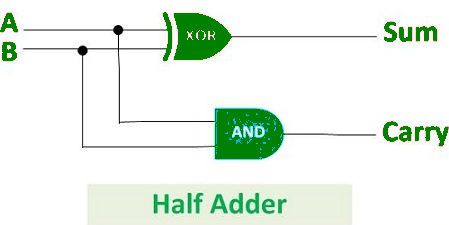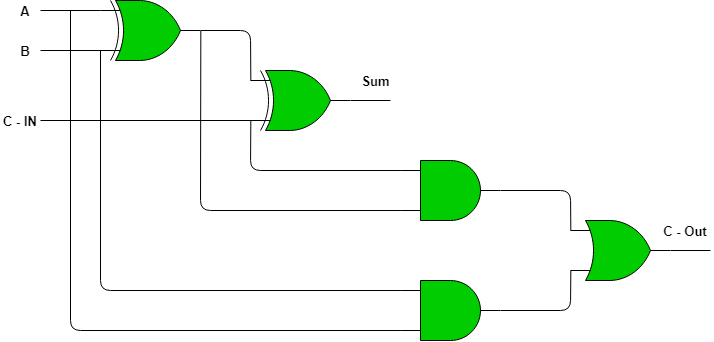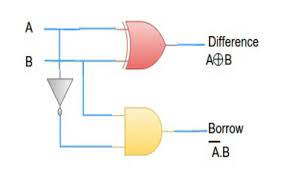Published by: Dikshya
Published date: 10 Jul 2023

A half adder is a combinational logic circuit that adds two binary digits (bits) together and produces a sum and a carry output. It does not consider any previous carry input. A  half adder consists of two inputs (A and B) and two outputs (Sum and Carry).
half adder consists of two inputs (A and B) and two outputs (Sum and Carry).
The truth table for a half adder is as follows:
| A | B | Sum | Carry |
|---|---|---|---|
| 0 | 0 | 0 | 0 |
| 0 | 1 | 1 | 0 |
| 1 | 0 | 1 | 0 |
| 1 | 1 | 0 | 1 |
The sum output represents the least significant bit of the addition, while the carry output represents the carry that is propagated to the next higher-order bit position.
A full adder is an extension of a half adder and considers both the current inputs and any carry input from the previous bit. It adds three binary digits (two inputs and a carry) and produces a sum and a carry output. A full adder has three inputs (A, B, and Carry-in) and two outputs (Sum and Carry-out).
The truth table for a full adder is as follows:
| A | B | Carry-in | Sum | Carry-out |
|---|---|---|---|---|
| 0 | 0 | 0 | 0 | 0 |
| 0 | 0 | 1 | 1 | 0 |
| 0 | 1 | 0 | 1 | 0 |
| 0 | 1 | 1 | 0 | 1 |
| 1 | 0 | 0 | 1 | 0 |
| 1 | 0 | 1 | 0 | 1 |
| 1 | 1 | 0 | 0 | 1 |
| 1 | 1 | 1 | 1 | 1 |
The sum output represents the least significant bit of the addition, while the carry-out represents the carry that is propagated to the next higher-order bit position.
 3. Half Subtractor:
3. Half Subtractor:A half subtractor is a combinational logic circuit used to subtract two single-bit binary numbers and produce a difference (subtraction result) and a borrow output. It operates similar to a half adder but with an additional borrow output. A half subtractor has two inputs (minuend and subtrahend) and two outputs (difference and borrow).
| A | B | Difference | Borrow |
|---|---|---|---|
| 0 | 0 | 0 | 0 |
| 0 | 1 | 1 | 1 |
| 1 | 0 | 1 | 0 |
| 1 | 1 | 0 | 0 |
The difference output represents the result of the subtraction, while the borrow output indicates whether a borrow (1) is required from the next lower-order bit during subtraction.
4. Full Subtractor:
A full subtractor is an extension of a half subtractor and considers not only the current inputs but also any borrow input from the previous bit position. It subtracts three single-bit binary numbers (minuend, subtrahend, and borrow) and produces a difference and a borrow output. A full subtractor has three inputs (A, B, and Borrow-in) and two outputs (Difference and Borrow-out).
The truth table for a full subtractor is as follows:
| A | B | Borrow-in | Difference | Borrow-out |
|---|---|---|---|---|
| 0 | 0 | 0 | 0 | 0 |
| 0 | 0 | 1 | 1 | 1 |
| 0 | 1 | 0 | 1 | 1 |
| 0 | 1 | 1 | 0 | 1 |
| 1 | 0 | 0 | 1 | 0 |
| 1 | 0 | 1 | 0 | 0 |
| 1 | 1 | 0 | 0 | 1 |
| 1 | 1 | 1 | 1 | 1 |
The difference output represents the result of the subtraction, while the borrow-out indicates whether a borrow (1) is required from the next lower-order bit during subtraction.
Half subtractors and full subtractors can be cascaded together to perform subtraction on multi-bit binary numbers. They are crucial components in arithmetic circuits, such as subtractors, arithmetic logic units (ALUs), and other applications involving binary subtraction.